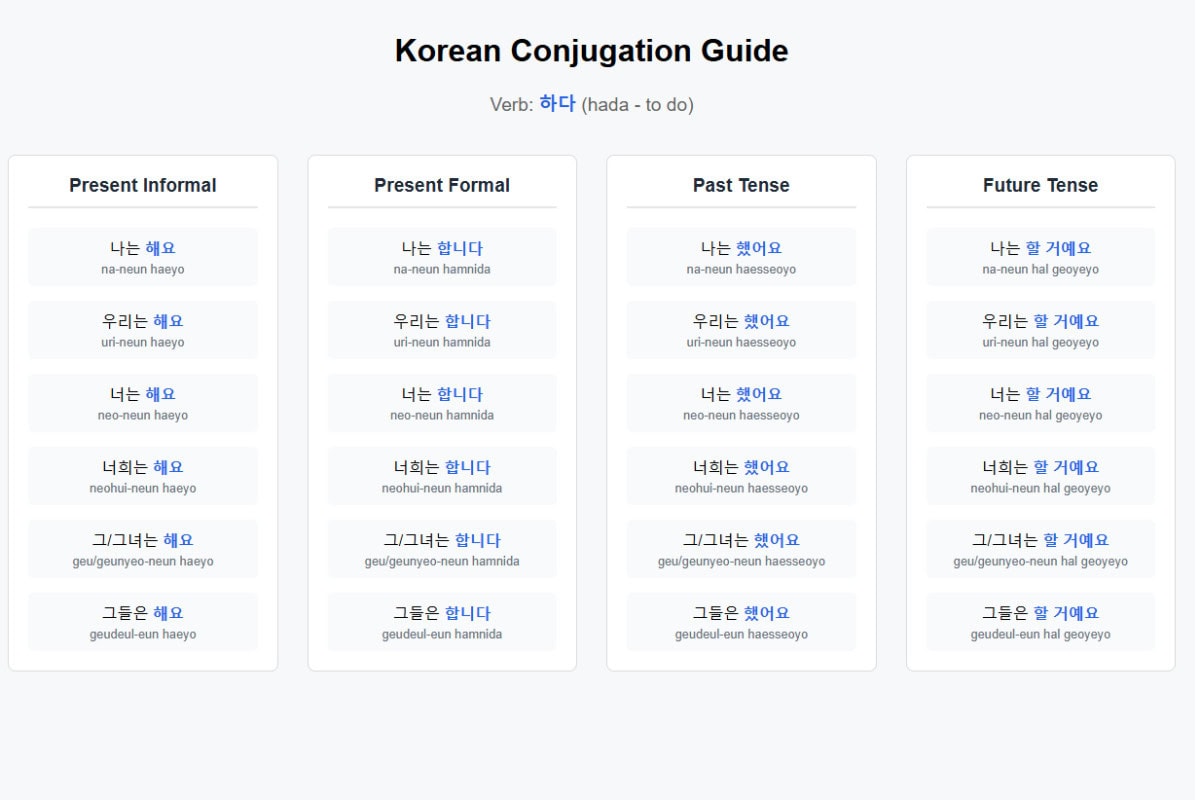Korean Verb Conjugator
Free Korean verb conjugation tool. Conjugate Korean verbs in both formal (존댓말) and informal (반말) forms with present, past, and future tenses.
Understanding Korean Verb Structure
Korean verbs always appear at the end of sentences and consist of a stem plus various endings. Unlike English, Korean verbs don’t change based on the subject (I, you, he/she/it, we, they). Instead, conjugation reflects tense, formality level, and speech style. All Korean verbs end in either 다 (-da) in their dictionary form.
Types of Korean Verbs
- 하다 (hada) Verbs: The most common and regular verb type, formed by adding 하다 to nouns (e.g., 공부하다 – to study, 운동하다 – to exercise)
- Regular Verbs: Follow standard conjugation patterns (e.g., 먹다 – to eat, 가다 – to go)
- Irregular Verbs:
- ㄹ Irregular: Drop ㄹ in certain conjugations (e.g., 알다 – to know)
- ㅂ Irregular: ㅂ changes to 우 (e.g., 덥다 – to be hot)
- 으 Irregular: Add 으 in specific forms (e.g., 쓰다 – to write)
- ㄷ Irregular: ㄷ changes to ㄹ (e.g., 듣다 – to hear)
Speech Levels in Korean
Korean has seven speech levels, but modern Korean primarily uses two:
- Formal Polite (존댓말): Endings like -ㅂ니다/-습니다
- Used in professional settings
- Speaking to strangers or elders
- Formal presentations or announcements
- Informal Polite (반말): Endings like -아요/-어요
- Used with friends and family
- Casual conversations
- Speaking to peers or juniors
Key Tense Markers
| Tense | Marker | Example |
|---|---|---|
| Present | -ㅂ니다/-아요 | 합니다/해요 (do) |
| Past | -았/었- | 했습니다/했어요 (did) |
| Future | -(으)ㄹ 것 | 할 것입니다/할 거예요 (will do) |
| Progressive | -고 있- | 하고 있습니다/하고 있어요 (doing) |
Common Conjugation Patterns
- Verb stems ending in vowels: Add endings directly
- Verb stems ending in consonants: Add 으 before certain endings
- Negative forms: Add 지 않다 after the stem
- Question forms: Change final intonation or add -까 to formal endings
Tips for Conjugation
- Identify the verb type (regular, irregular, 하다)
- Determine the appropriate speech level
- Choose the tense or mood
- Apply any necessary irregular conjugation rules
- Add the appropriate ending

